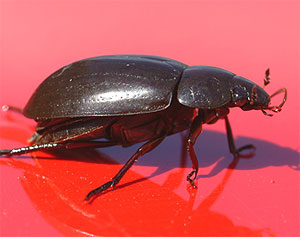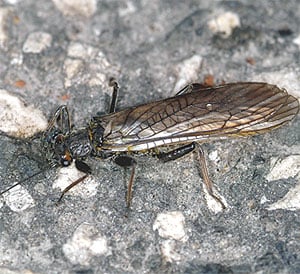WASHINGTON, Jan. 7, 2009 – Animals that rely on light cues to navigate their environment are being affected by man-made light sources that can alter natural light cycles.
A collaboration of ecologists, biologists and biophysicists has shown that polarized as well as direct light can trigger certain animal behaviors and that the animals' responses to polarized light can lead to injury and often death.

A water beetle is attracted to the sheen from a red car. Images courtesy of György Kriska.
The findings of an article published in the journal Frontiers in Ecology and the Environment indicate that artificial light – often called light pollution – can attract or repulse animals. The behavioral results include migration in the wrong direction, bad selection of nest sites or mates, collision with artificial structures, increased predation and a reduction in time available to look for food, just to name a few.
In a classic example, when baby sea turtles emerge from their beach nests, they use the reflections of starlight and moonlight off the water surface to help orient themselves toward the ocean. In urbanized areas, many turtles migrate toward the bright lights of buildings or street lights, jeopardizing their safety.
"Environmental cues, such as the intensity of light that animals use to make decisions, occur at different levels of severity in the natural world," explains Bruce Robertson, an ecologist at Michigan State University. "When cues become unnaturally intense, animals can respond unnaturally strongly to them."
According to Robertson, that heightened response happens because of the way humans have altered the environment.
In the study, lead author Gabor Horvath, Robertson and their colleagues explain that many animals are also thrown off course by light reflecting from man-made structures. The darker and smoother a surface is, the more highly polarized its reflected light. In most cases, artificial polarized light symbolizes one thing to animals.
"For example, the primary source of horizontally polarized light in nature is water," says Robertson. "Biologists discovered in the 1980s that such polarized light is an amazingly reliable cue for finding bodies of water."
A Stonefly lays eggs on granite.
Especially in the case of dragonflies and other insects, which often lay their eggs and spend their first phase of life in ponds, streams and lakes, mistaking human-made objects for water can be deadly.
Shiny, dark surfaces – such as asphalt, cars, glass building surfaces and plastic sheeting – reflect light that is more strongly polarized than horizontally polarized light reflected by water. This intensity augments the animals' attraction to it. When, for example, insects mistake the sheen of an oil slick for water, their predators often follow them to the source and risk becoming trapped and drowning, as in the La Brea tar pits of Los Angeles and other oil-slicked lakes around the world.
This study suggests that polarized light pollution can disrupt the entire food web in an ecosystem.
If the attraction to the polarized light source is great enough, even in the absence of a physical trap, animals cannot remove themselves from it, ultimately dying from dehydration and exhaustion. For example, after laying its eggs on a shiny-black highway, a dragonfly may become paralyzed by its attraction to the pavement, effectively dooming its own fate and that of its offspring.
These so-called ecological traps occur when environmental change happens more quickly than animals can evolve to react to it. If large numbers of animals fall victim to these false cues, says Robertson, population numbers could decline, perhaps to extinction.
There are several ways humans can ameliorate the effects of their overlarge dark, shiny structures. Preliminary studies show that white hatch marks on roads can prevent insects from mistaking them for bodies of water. The addition of white curtains to shiny-black buildings, suggests Robertson, also deters insects, bats and birds.
"It's yet another case where we're faced with a choice between what's more expensive or what's better for biodiversity," Robertson says. "Aquatic insects are the foundation of the food web, and what's harmful to them is harmful to entire ecosystems and the services they provide."
For more information, visit: www.esa.org